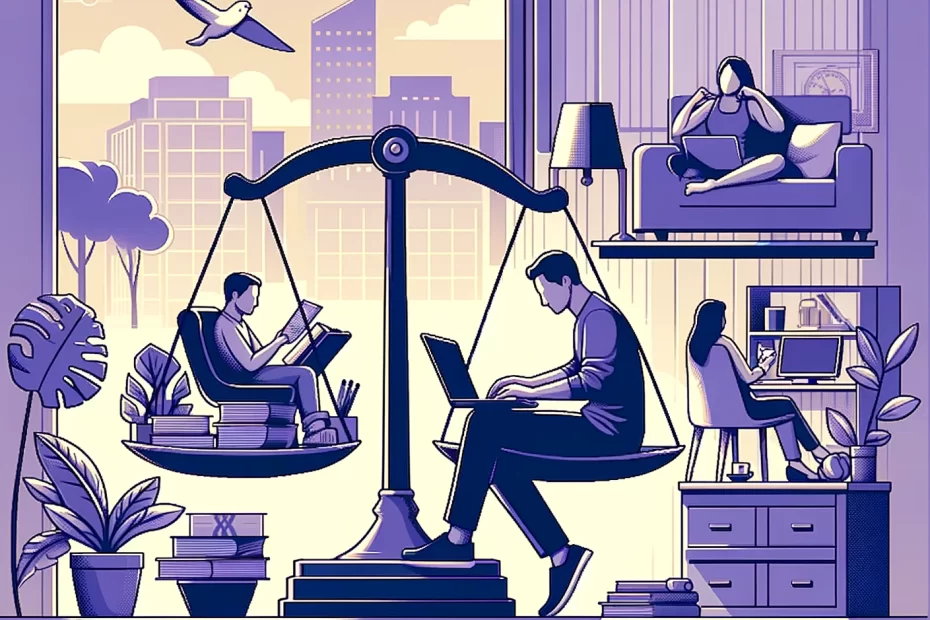Building work-life balance is crucial for both employees and employers. It not only leads to happier, more satisfied employees but also benefits the company in several ways. Happy employees make smarter decisions, are less likely to quit, provide better customer service, are more creative, and spread happiness to others. To keep employees happy and productive, it’s important to prioritize work-life balance and implement strategies such as offering flexible working options, listening to employees, creating career mobility, and building a positive work environment.
The Importance of Work-Life Balance in the Workplace
Work-life balance is a crucial aspect of any workplace, impacting employee well-being, job satisfaction, productivity, and overall mental health. Employers who prioritize work-life balance create a positive work culture and are more successful in retaining top talent.
Achieving a healthy work-life balance has numerous benefits, both for employees and the organization as a whole. When individuals have a proper balance between work and personal life, they experience reduced stress levels and are less likely to suffer from burnout. This, in turn, leads to improved overall work performance and a higher sense of job satisfaction.
Companies that prioritize work-life balance also tend to have higher employee retention rates. When employees are content with their work-life balance, they are less likely to leave the organization in search of better opportunities. This not only saves on the costs associated with recruitment and training but also ensures a stable workforce in the long run.
Moreover, a workplace that supports work-life balance cultivates a positive employer brand. This attracts top talent and positions the organization as a desirable place to work, which can give the company a competitive edge in the job market. By creating an environment that values work-life balance, employers foster a harmonious workplace where employees can thrive both professionally and personally.
To create an ideal work-life balance in the workplace, employers can introduce initiatives such as flexible working options, allowing employees to have more control over their schedules. Additionally, organizations can prioritize open communication and create a supportive work environment where employees feel comfortable discussing their work-life needs.
Overall, work-life balance is not just a buzzword; it is a fundamental aspect of building a successful and fulfilling professional and personal life. By recognizing the importance of work-life balance and implementing strategies to support it, employers can create a workplace that promotes employee well-being, engagement, and long-term organizational success.

The Evolution of Work-Life Balance in Recent Years
The concept of work-life balance has undergone significant changes in recent years, primarily due to the increasing prevalence of remote work and hybrid work arrangements. In 2019, many employees struggled with maintaining work-life balance, often facing long working hours that spilled into evenings and weekends. This resulted in heightened stress levels and decreased overall well-being.
However, the onset of the pandemic brought about a substantial shift in the way we work. With the need for social distancing and remote work becoming the norm, more individuals began working from home, thus experiencing a significant transformation in their work-life balance.
Remote work, in particular, provided certain individuals with increased flexibility, allowing them to better integrate their professional and personal obligations. This newfound harmonization between work and personal life contributed to a more conducive and fulfilling lifestyle.
On the other hand, some employees have struggled to maintain a healthy work-life balance despite the benefits of remote work. The blurring of boundaries between work and personal life, lack of distinction between work hours and leisure time, and the absence of physical separation from the office environment have presented challenges for individuals striving to find a balance.
It is essential for employers to recognize this evolving landscape and adapt their policies to support their employees in achieving work-life balance in the new normal. Employers can adopt measures such as flexible work schedules, encouraging regular breaks, and promoting open communication to enable their workforce to strike a harmonious balance between work and personal life.
7 Tips for Achieving Work-Life Balance
Achieving work-life balance is essential for a fulfilling and well-rounded life. Here are some practical tips that individuals can implement to achieve a healthy balance:
- Set boundaries: Establish clear boundaries between work and personal life. Communicate your availability and dedicate specific time for leisure activities and personal commitments.
- Manage your time: Prioritize tasks and create a schedule that allows for adequate work and personal time. Avoid overcommitting and learn to delegate tasks when necessary.
- Practice self-care: Take care of your physical and mental well-being. Engage in activities that help you relax and recharge, such as exercise, meditation, or pursuing hobbies.
- Unplug regularly: Disconnect from work-related devices and technology during non-work hours. Give yourself the freedom to fully engage with your personal life without constant work interruptions.
- Delegate and outsource: Learn to delegate tasks at work and consider outsourcing household chores or other responsibilities that consume your time and energy.
- Communicate with your employer: Have open and honest conversations with your employer about your work-life balance needs. Discuss flexible work arrangements or alternative schedules that better suit your lifestyle.
- Prioritize what matters: Identify your priorities and align your time and energy accordingly. Focus on activities and relationships that bring you joy and fulfillment.
1 Extra Tip!
When building out a listicle-style post, you try to keep it to catchy numbers. However, this list wouldn’t be complete without one more special tip:
Learn to say no: It’s okay to decline nonessential tasks or commitments that may disrupt your work-life balance. Prioritize your well-being and understand that saying no is necessary at times.
Conclusion
Building work-life balance is crucial for both individuals and companies. When employees have a healthy work-life balance, they are happier, more productive, and contribute to a positive work culture. Prioritizing work-life balance is key to creating a thriving workplace.
Employers can foster work-life balance by offering flexible working options that cater to individual needs and preferences. By listening to employees and understanding their unique challenges, employers can create an environment that supports work-life balance and overall well-being.
Recognizing the evolution of work-life balance is vital, especially with the rise of remote and hybrid work arrangements. Employers must adapt their policies and strategies to meet the changing needs of employees. By implementing practical tips and strategies, individuals can achieve a better work-life balance and find fulfillment in both their professional and personal lives.
FAQ
What is work-life balance?
Work-life balance refers to the equilibrium between work-related demands and personal life responsibilities. It involves effectively managing time and energy to maintain a healthy and fulfilling personal and professional life.
Why is work-life balance important?
Work-life balance is crucial for overall well-being as it helps reduce stress, prevent burnout, and improve mental health. It also leads to happier, more satisfied employees and contributes to a positive work culture.
How can employers promote work-life balance in the workplace?
Employers can promote work-life balance by offering flexible working options, listening to employees’ needs and concerns, creating career mobility opportunities, and fostering a positive work environment that supports work-life balance.
How does work-life balance benefit a company?
Work-life balance benefits a company in several ways. It leads to higher employee retention rates, enhanced productivity, better customer service, increased creativity, and a positive employer brand.
How has work-life balance evolved in recent years?
Work-life balance has evolved due to factors such as remote work and hybrid work arrangements. The COVID-19 pandemic has further accelerated this evolution, with more individuals experiencing a transformation in their work-life balance.
What are some practical tips for achieving work-life balance?
Some practical tips for achieving work-life balance include setting boundaries between work and personal life, prioritizing self-care, delegating tasks, managing time effectively, and seeking support from friends, family, or professionals when needed.
How can individuals achieve work-life balance while working remotely?
Individuals can achieve work-life balance while working remotely by creating a dedicated workspace, establishing a routine, setting clear work hours, taking regular breaks, and maintaining open communication with their team.

